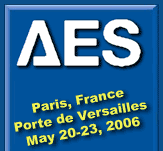

Home | Technical Program | Exhibition | Visitors | Students | Press
Last Updated: 20060404, mei
P28 - Audio Recording and ReproductionTuesday, May 23, 12:00 — 13:20
Chair: Geoff Martin, Bang & Olufsen A/S - Struer, Denmark
P28-1 Multichannel High Performance Analog Volume Control with a New Serial I2C/SPI Compatible Control Port—Vivek Saraf, Chad Hardy, John Tucker, Johann Gaboriau, Cirrus Logic, Inc. - Austin, TX, USA
A new scheme for digitally operating an 8-channel high-performance analog volume control is proposed. Along with being I2C/SPI compatible, this scheme is faster and less complex than existing solutions due to its inherent advanced support for group/individual addressing. The volume control varies monotonically all the way from -96 dB to +22 dB in 0.25 dB steps. The chip achieves 110 dB THD+N, 1.8 µVrms total integrated noise and an interchannel isolation of greater than 120 dB.
[Associated Poster Presentation in Session P31, Tuesday, May 23, at 14:00]
Presentation is scheduled to begin at 12:00
Convention Paper 6847 (Purchase now)
P28-2 Evaluation of Ambience Microphone Arrangements Utilizing Frequency Dependent Spatial Cross Correlation (FSCC)—Teruo Muraoka, University of Tokyo - Tokyo, Japan
Ambience in stereophonic recording is mostly determined with the main microphone system. The authors examined the effect utilizing Frequency-dependent Spatial Cross Correlation (FSCC), which is defined as a cross correlation of two outputs of the above-mentioned microphone system. If the recording sound field is diffusive, the above FSCC is desired to be zero. However, actual FSCC varies within -1 to 1 depending on frequency; that is brought by the microphone’s directionality and location. The authors theoretically analyzed FSCCs of typical main microphone systems such as AB system, ORTF system, WF system, and MS system and discovered that the FSCC of MS system becomes uniformly zero under conditions when its azimuth of directional angles is set at 132-degrees. This was proven experimentally, and excellent ambient recording was achieved.
[Associated Poster Presentation in Session P31, Tuesday, May 23, at 14:00]
Presentation is scheduled to begin at 12:20
Convention Paper 6848 (Purchase now)
P28-3 Parameter Estimation of Dynamic Range Compressors: Models, Procedures, and Test Signals—Uwe Simmer, University of Applied Sciences Oldenburg/Ostfriesland/Wilhelmshave - Oldenburg, Germany; Denny Schmidt, University of Bremen - Bremen, Germany; Joerg Bitzer, University of Applied Sciences Oldenburg/Ostfriesland/Wilhelmshave - Oldenburg, Germany
An analysis of digital dynamic range compression algorithms is presented. They are studied by employing a single-band feed-forward compressor model allowing the use of independent attack and release times for both RMS detection and gain smoothing. Artificial test signals for measuring the static and dynamic compressor characteristics are discussed. The parameters of the compressor model are estimated by fitting the model output to the output of the compressor under test by using the simplex method. The results are verified by comparing the output levels of the actual and the fitted compressor for real world audio samples.
[Associated Poster Presentation in Session P31, Tuesday, May 23, at 14:00]
Presentation is scheduled to begin at 12:40
Convention Paper 6849 (Purchase now)
P28-4 Redefining the Directivity Index for Adaptive Microphone Arrays—Daniel Schobben, Philips Research Laboratories - Eindhoven, The Netherlands
The Directivity Index (DI) allows for quantifying the directivity of a microphone or a nonadaptive array of microphones. The DI indicates how well a target sound source can be extracted in the presence of diffuse background noise. Adaptive microphone arrays have the potential to provide an improved performance for suppressing distracters that are spatially apart from the target sound source. In the absence of performance measures for adaptive microphone arrays, the DI has been used to evaluate adaptive microphone arrays in both anechoic and diffuse noise conditions. For adaptive microphone arrays the DI may not reflect the real-life performance of the array however, with theoretical directivity values that can be driven to infinity for spatially separated target and distracter sound sources in anechoic conditions, while such conditions will hardly be encountered in daily life. On the other hand, adaptive microphone arrays inherently do not have improved performance in diffuse sound fields for which the DI originally has been defined. Starting from the definition of DI a new measure for adaptive arrays is introduced in this paper as an objective measure for quantifying improvements in signal-to-noise based on directivity.
Presentation is scheduled to begin at 13:00
Convention Paper 6850 (Purchase now)